University Auditing and Assurance Case Study Report Analysis
VerifiedAdded on 2022/08/22
|8
|1494
|18
Report
AI Summary
This report presents an analysis of an auditing and assurance case study, addressing key concepts and procedures. It begins with an overview of analytical procedures, explaining their role in risk assessment, substantive testing, and final review. The report then delves into professional skepticism, highlighting its importance in detecting fraud and errors. Materiality is discussed, including benchmark selection and its impact on audit planning. Furthermore, the report includes a ratio analysis, assessing the financial performance of a company, and discussing the implications of the findings. The report is based on the course MAA303, covering the principles of auditing and assurance.
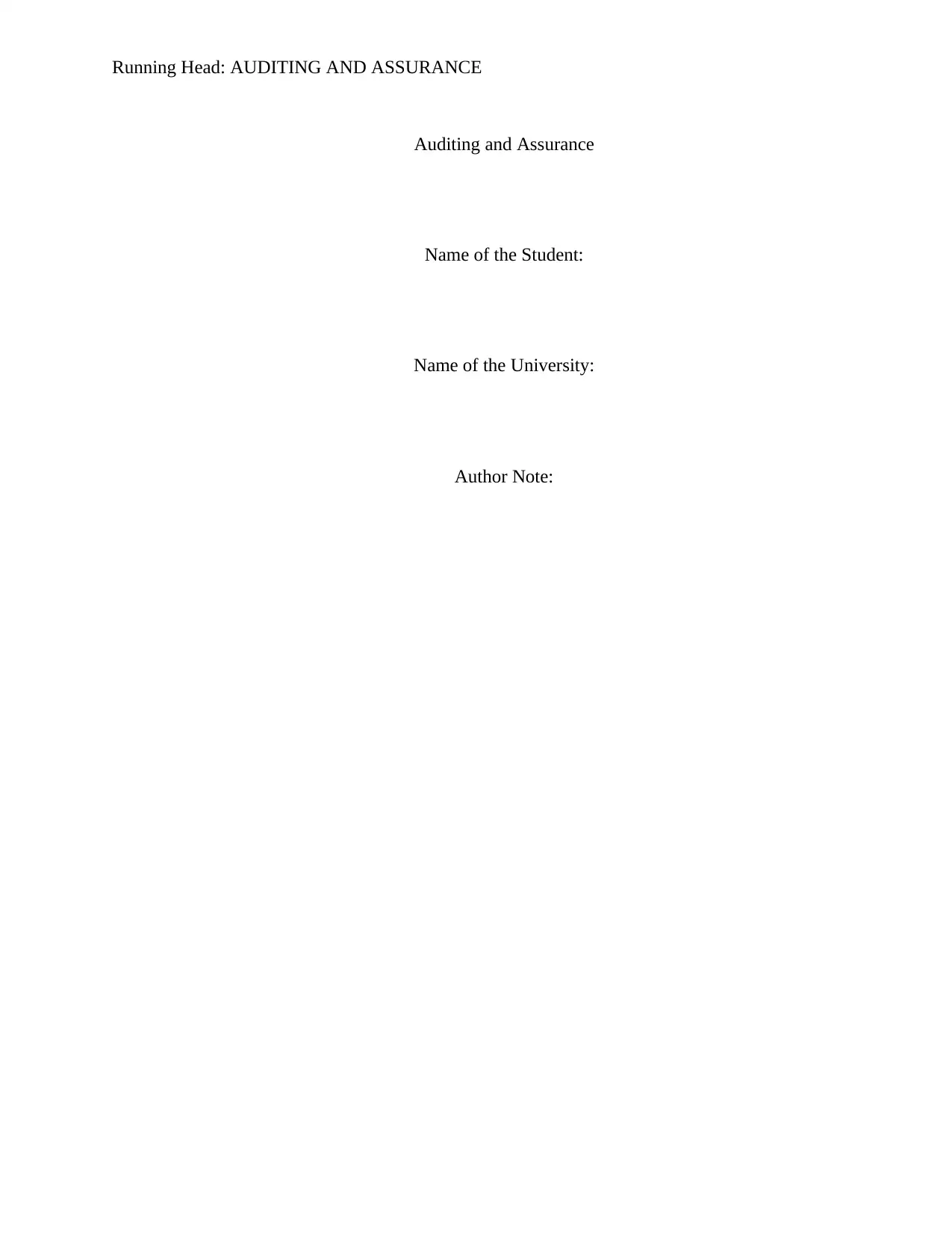
Running Head: AUDITING AND ASSURANCE
Auditing and Assurance
Name of the Student:
Name of the University:
Author Note:
Auditing and Assurance
Name of the Student:
Name of the University:
Author Note:
Paraphrase This Document
Need a fresh take? Get an instant paraphrase of this document with our AI Paraphraser
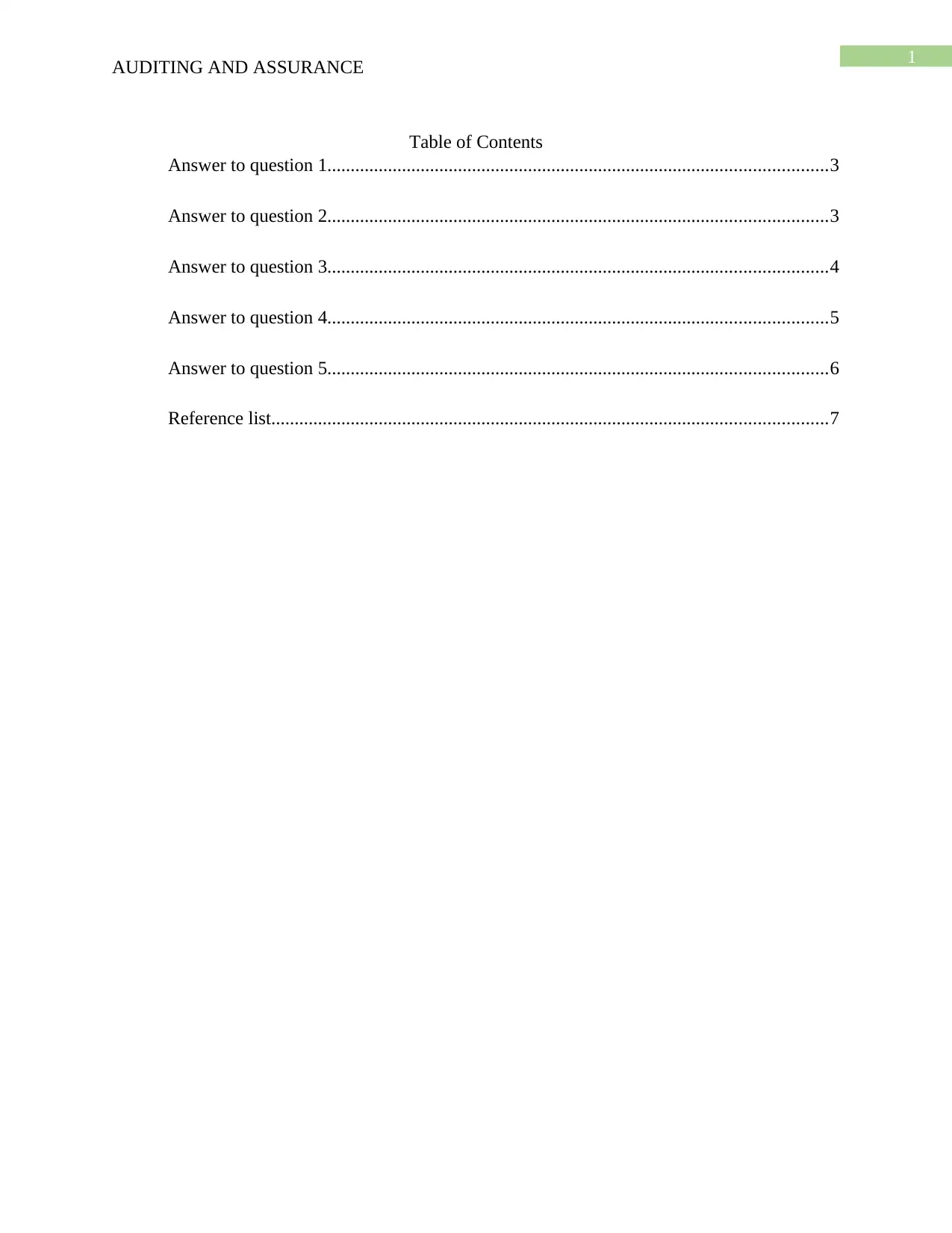
1
AUDITING AND ASSURANCE
Table of Contents
Answer to question 1...........................................................................................................3
Answer to question 2...........................................................................................................3
Answer to question 3...........................................................................................................4
Answer to question 4...........................................................................................................5
Answer to question 5...........................................................................................................6
Reference list.......................................................................................................................7
AUDITING AND ASSURANCE
Table of Contents
Answer to question 1...........................................................................................................3
Answer to question 2...........................................................................................................3
Answer to question 3...........................................................................................................4
Answer to question 4...........................................................................................................5
Answer to question 5...........................................................................................................6
Reference list.......................................................................................................................7
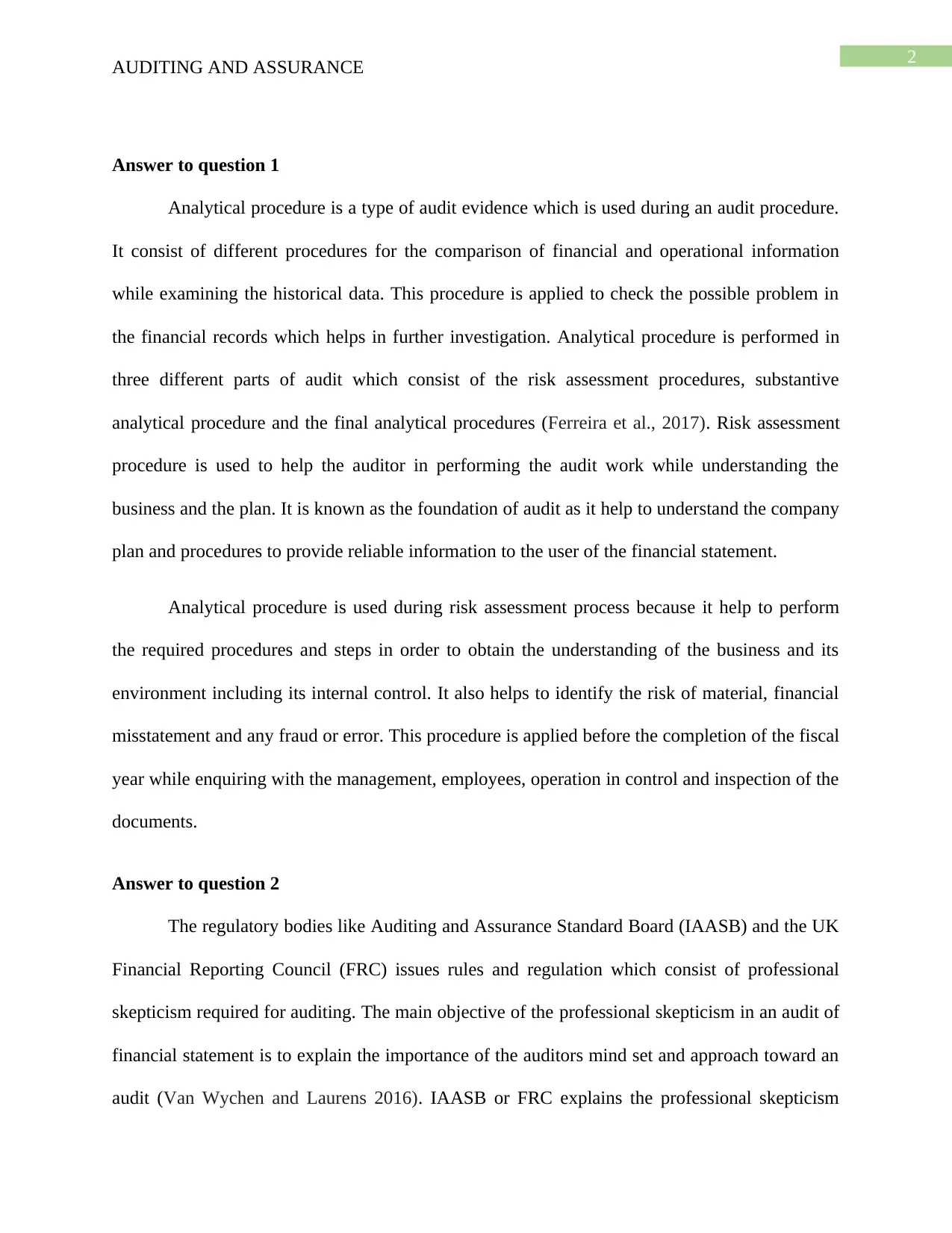
2
AUDITING AND ASSURANCE
Answer to question 1
Analytical procedure is a type of audit evidence which is used during an audit procedure.
It consist of different procedures for the comparison of financial and operational information
while examining the historical data. This procedure is applied to check the possible problem in
the financial records which helps in further investigation. Analytical procedure is performed in
three different parts of audit which consist of the risk assessment procedures, substantive
analytical procedure and the final analytical procedures (Ferreira et al., 2017). Risk assessment
procedure is used to help the auditor in performing the audit work while understanding the
business and the plan. It is known as the foundation of audit as it help to understand the company
plan and procedures to provide reliable information to the user of the financial statement.
Analytical procedure is used during risk assessment process because it help to perform
the required procedures and steps in order to obtain the understanding of the business and its
environment including its internal control. It also helps to identify the risk of material, financial
misstatement and any fraud or error. This procedure is applied before the completion of the fiscal
year while enquiring with the management, employees, operation in control and inspection of the
documents.
Answer to question 2
The regulatory bodies like Auditing and Assurance Standard Board (IAASB) and the UK
Financial Reporting Council (FRC) issues rules and regulation which consist of professional
skepticism required for auditing. The main objective of the professional skepticism in an audit of
financial statement is to explain the importance of the auditors mind set and approach toward an
audit (Van Wychen and Laurens 2016). IAASB or FRC explains the professional skepticism
AUDITING AND ASSURANCE
Answer to question 1
Analytical procedure is a type of audit evidence which is used during an audit procedure.
It consist of different procedures for the comparison of financial and operational information
while examining the historical data. This procedure is applied to check the possible problem in
the financial records which helps in further investigation. Analytical procedure is performed in
three different parts of audit which consist of the risk assessment procedures, substantive
analytical procedure and the final analytical procedures (Ferreira et al., 2017). Risk assessment
procedure is used to help the auditor in performing the audit work while understanding the
business and the plan. It is known as the foundation of audit as it help to understand the company
plan and procedures to provide reliable information to the user of the financial statement.
Analytical procedure is used during risk assessment process because it help to perform
the required procedures and steps in order to obtain the understanding of the business and its
environment including its internal control. It also helps to identify the risk of material, financial
misstatement and any fraud or error. This procedure is applied before the completion of the fiscal
year while enquiring with the management, employees, operation in control and inspection of the
documents.
Answer to question 2
The regulatory bodies like Auditing and Assurance Standard Board (IAASB) and the UK
Financial Reporting Council (FRC) issues rules and regulation which consist of professional
skepticism required for auditing. The main objective of the professional skepticism in an audit of
financial statement is to explain the importance of the auditors mind set and approach toward an
audit (Van Wychen and Laurens 2016). IAASB or FRC explains the professional skepticism
⊘ This is a preview!⊘
Do you want full access?
Subscribe today to unlock all pages.

Trusted by 1+ million students worldwide
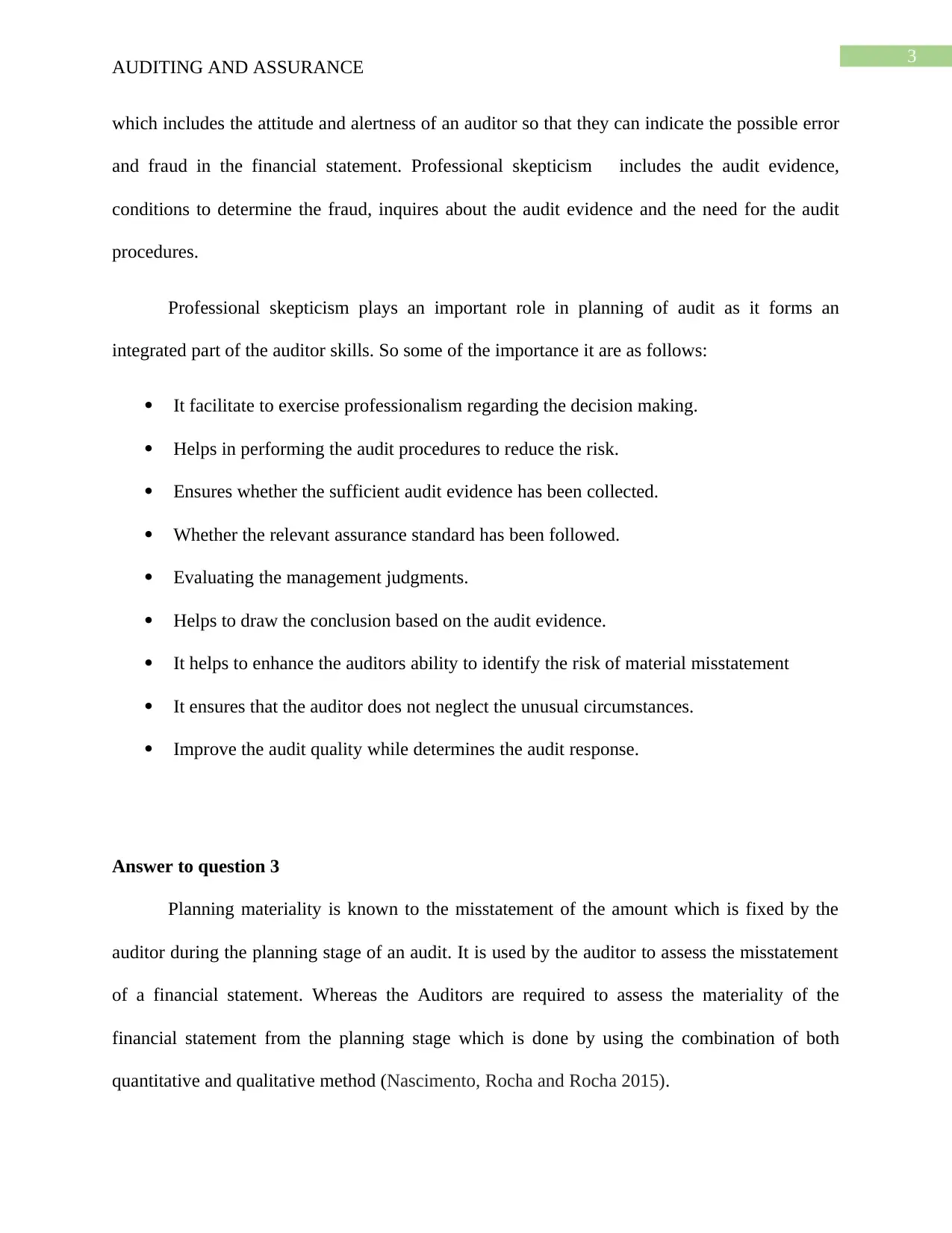
3
AUDITING AND ASSURANCE
which includes the attitude and alertness of an auditor so that they can indicate the possible error
and fraud in the financial statement. Professional skepticism includes the audit evidence,
conditions to determine the fraud, inquires about the audit evidence and the need for the audit
procedures.
Professional skepticism plays an important role in planning of audit as it forms an
integrated part of the auditor skills. So some of the importance it are as follows:
It facilitate to exercise professionalism regarding the decision making.
Helps in performing the audit procedures to reduce the risk.
Ensures whether the sufficient audit evidence has been collected.
Whether the relevant assurance standard has been followed.
Evaluating the management judgments.
Helps to draw the conclusion based on the audit evidence.
It helps to enhance the auditors ability to identify the risk of material misstatement
It ensures that the auditor does not neglect the unusual circumstances.
Improve the audit quality while determines the audit response.
Answer to question 3
Planning materiality is known to the misstatement of the amount which is fixed by the
auditor during the planning stage of an audit. It is used by the auditor to assess the misstatement
of a financial statement. Whereas the Auditors are required to assess the materiality of the
financial statement from the planning stage which is done by using the combination of both
quantitative and qualitative method (Nascimento, Rocha and Rocha 2015).
AUDITING AND ASSURANCE
which includes the attitude and alertness of an auditor so that they can indicate the possible error
and fraud in the financial statement. Professional skepticism includes the audit evidence,
conditions to determine the fraud, inquires about the audit evidence and the need for the audit
procedures.
Professional skepticism plays an important role in planning of audit as it forms an
integrated part of the auditor skills. So some of the importance it are as follows:
It facilitate to exercise professionalism regarding the decision making.
Helps in performing the audit procedures to reduce the risk.
Ensures whether the sufficient audit evidence has been collected.
Whether the relevant assurance standard has been followed.
Evaluating the management judgments.
Helps to draw the conclusion based on the audit evidence.
It helps to enhance the auditors ability to identify the risk of material misstatement
It ensures that the auditor does not neglect the unusual circumstances.
Improve the audit quality while determines the audit response.
Answer to question 3
Planning materiality is known to the misstatement of the amount which is fixed by the
auditor during the planning stage of an audit. It is used by the auditor to assess the misstatement
of a financial statement. Whereas the Auditors are required to assess the materiality of the
financial statement from the planning stage which is done by using the combination of both
quantitative and qualitative method (Nascimento, Rocha and Rocha 2015).
Paraphrase This Document
Need a fresh take? Get an instant paraphrase of this document with our AI Paraphraser
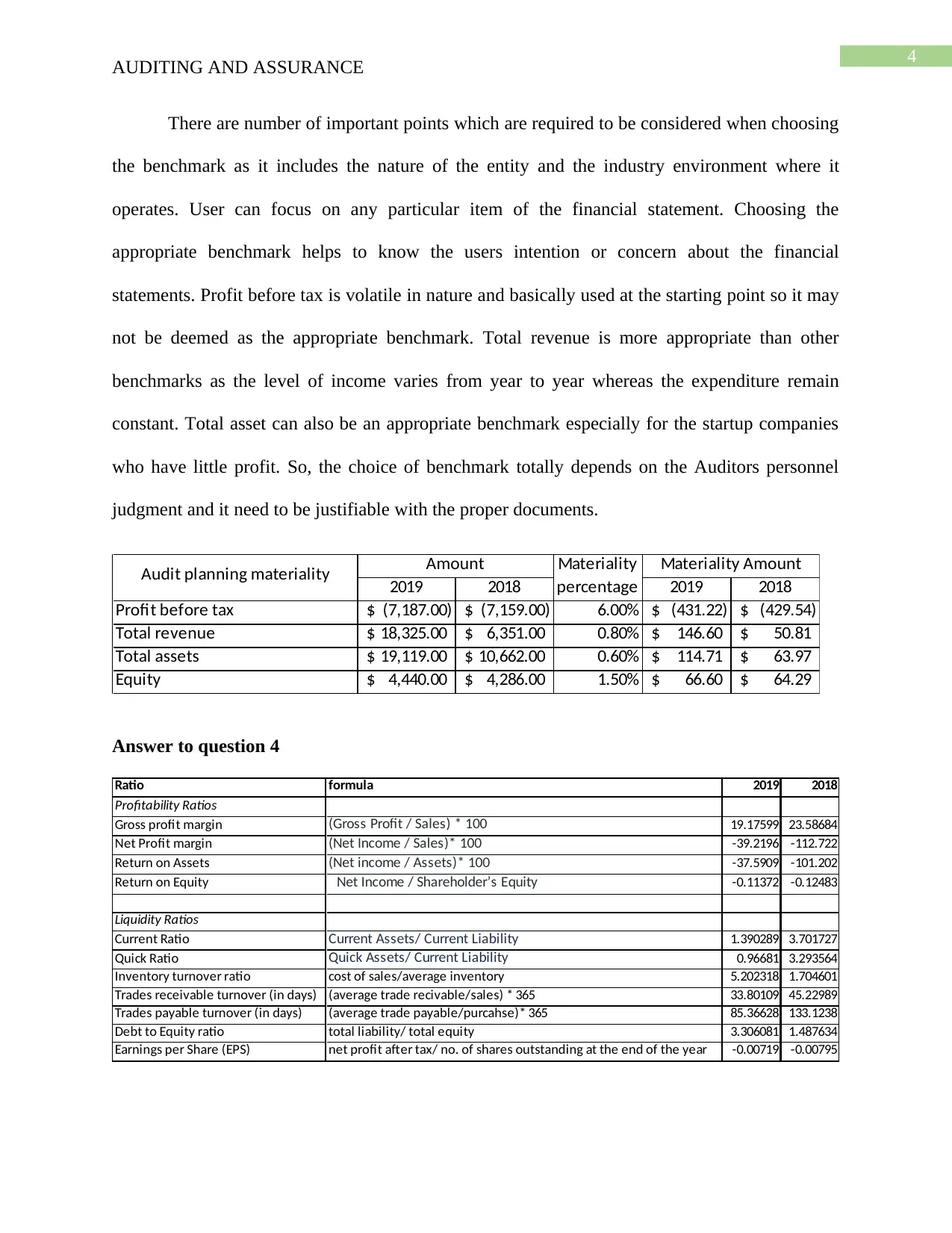
4
AUDITING AND ASSURANCE
There are number of important points which are required to be considered when choosing
the benchmark as it includes the nature of the entity and the industry environment where it
operates. User can focus on any particular item of the financial statement. Choosing the
appropriate benchmark helps to know the users intention or concern about the financial
statements. Profit before tax is volatile in nature and basically used at the starting point so it may
not be deemed as the appropriate benchmark. Total revenue is more appropriate than other
benchmarks as the level of income varies from year to year whereas the expenditure remain
constant. Total asset can also be an appropriate benchmark especially for the startup companies
who have little profit. So, the choice of benchmark totally depends on the Auditors personnel
judgment and it need to be justifiable with the proper documents.
2019 2018 2019 2018
Profit before tax (7,187.00)$ (7,159.00)$ 6.00% (431.22)$ (429.54)$
Total revenue 18,325.00$ 6,351.00$ 0.80% 146.60$ 50.81$
Total assets 19,119.00$ 10,662.00$ 0.60% 114.71$ 63.97$
Equity 4,440.00$ 4,286.00$ 1.50% 66.60$ 64.29$
Materiality
percentage
Amount Materiality Amount
Audit planning materiality
Answer to question 4
Ratio formula 2019 2018
Profitability Ratios
Gross profit margin (Gross Profit / Sales) * 100 19.17599 23.58684
Net Profit margin (Net Income / Sales)* 100 -39.2196 -112.722
Return on Assets (Net income / Assets)* 100 -37.5909 -101.202
Return on Equity Net Income / Shareholder’s Equity -0.11372 -0.12483
Liquidity Ratios
Current Ratio Current Assets/ Current Liability 1.390289 3.701727
Quick Ratio Quick Assets/ Current Liability 0.96681 3.293564
Inventory turnover ratio cost of sales/average inventory 5.202318 1.704601
Trades receivable turnover (in days) (average trade recivable/sales) * 365 33.80109 45.22989
Trades payable turnover (in days) (average trade payable/purcahse)* 365 85.36628 133.1238
Debt to Equity ratio total liability/ total equity 3.306081 1.487634
Earnings per Share (EPS) net profit after tax/ no. of shares outstanding at the end of the year -0.00719 -0.00795
AUDITING AND ASSURANCE
There are number of important points which are required to be considered when choosing
the benchmark as it includes the nature of the entity and the industry environment where it
operates. User can focus on any particular item of the financial statement. Choosing the
appropriate benchmark helps to know the users intention or concern about the financial
statements. Profit before tax is volatile in nature and basically used at the starting point so it may
not be deemed as the appropriate benchmark. Total revenue is more appropriate than other
benchmarks as the level of income varies from year to year whereas the expenditure remain
constant. Total asset can also be an appropriate benchmark especially for the startup companies
who have little profit. So, the choice of benchmark totally depends on the Auditors personnel
judgment and it need to be justifiable with the proper documents.
2019 2018 2019 2018
Profit before tax (7,187.00)$ (7,159.00)$ 6.00% (431.22)$ (429.54)$
Total revenue 18,325.00$ 6,351.00$ 0.80% 146.60$ 50.81$
Total assets 19,119.00$ 10,662.00$ 0.60% 114.71$ 63.97$
Equity 4,440.00$ 4,286.00$ 1.50% 66.60$ 64.29$
Materiality
percentage
Amount Materiality Amount
Audit planning materiality
Answer to question 4
Ratio formula 2019 2018
Profitability Ratios
Gross profit margin (Gross Profit / Sales) * 100 19.17599 23.58684
Net Profit margin (Net Income / Sales)* 100 -39.2196 -112.722
Return on Assets (Net income / Assets)* 100 -37.5909 -101.202
Return on Equity Net Income / Shareholder’s Equity -0.11372 -0.12483
Liquidity Ratios
Current Ratio Current Assets/ Current Liability 1.390289 3.701727
Quick Ratio Quick Assets/ Current Liability 0.96681 3.293564
Inventory turnover ratio cost of sales/average inventory 5.202318 1.704601
Trades receivable turnover (in days) (average trade recivable/sales) * 365 33.80109 45.22989
Trades payable turnover (in days) (average trade payable/purcahse)* 365 85.36628 133.1238
Debt to Equity ratio total liability/ total equity 3.306081 1.487634
Earnings per Share (EPS) net profit after tax/ no. of shares outstanding at the end of the year -0.00719 -0.00795
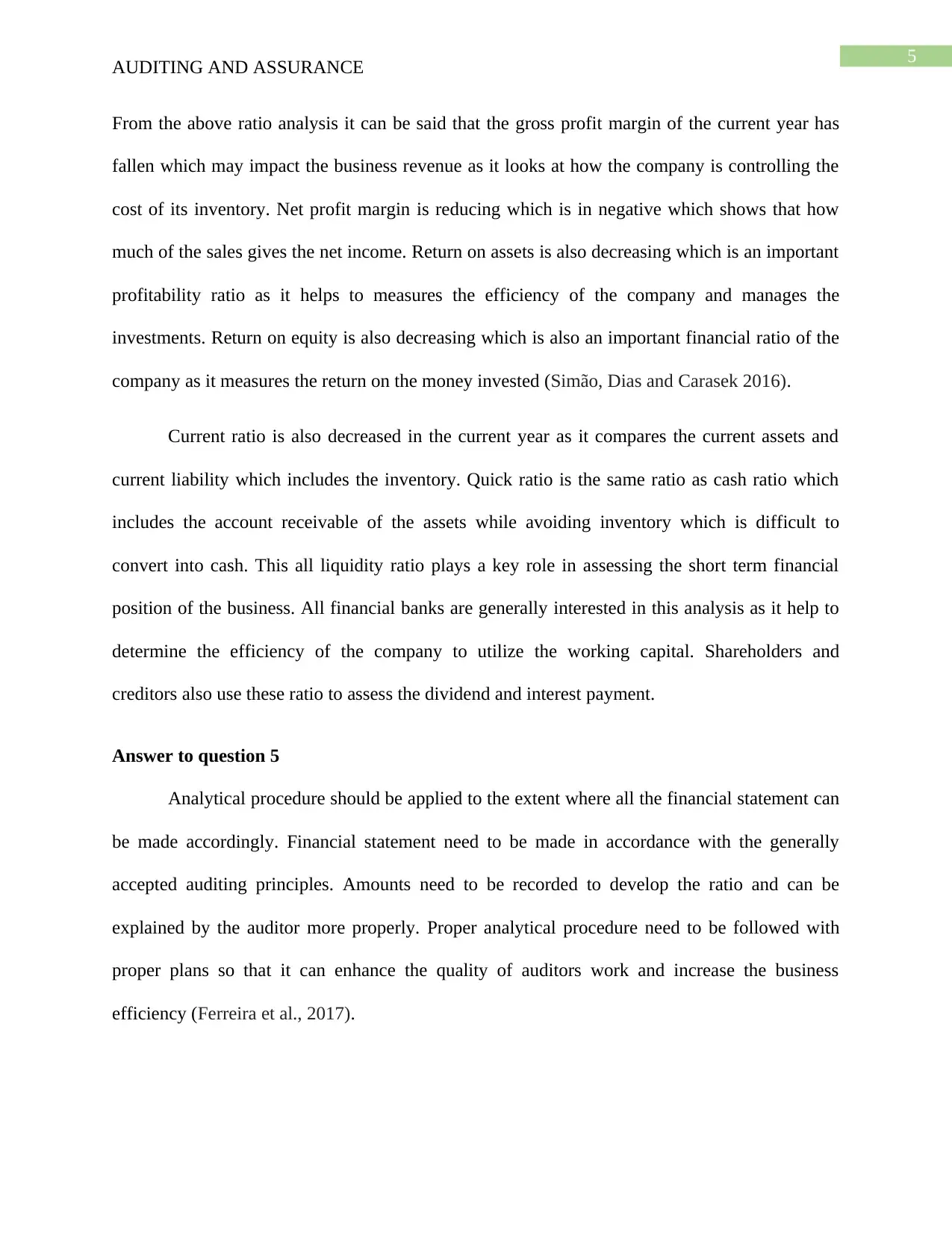
5
AUDITING AND ASSURANCE
From the above ratio analysis it can be said that the gross profit margin of the current year has
fallen which may impact the business revenue as it looks at how the company is controlling the
cost of its inventory. Net profit margin is reducing which is in negative which shows that how
much of the sales gives the net income. Return on assets is also decreasing which is an important
profitability ratio as it helps to measures the efficiency of the company and manages the
investments. Return on equity is also decreasing which is also an important financial ratio of the
company as it measures the return on the money invested (Simão, Dias and Carasek 2016).
Current ratio is also decreased in the current year as it compares the current assets and
current liability which includes the inventory. Quick ratio is the same ratio as cash ratio which
includes the account receivable of the assets while avoiding inventory which is difficult to
convert into cash. This all liquidity ratio plays a key role in assessing the short term financial
position of the business. All financial banks are generally interested in this analysis as it help to
determine the efficiency of the company to utilize the working capital. Shareholders and
creditors also use these ratio to assess the dividend and interest payment.
Answer to question 5
Analytical procedure should be applied to the extent where all the financial statement can
be made accordingly. Financial statement need to be made in accordance with the generally
accepted auditing principles. Amounts need to be recorded to develop the ratio and can be
explained by the auditor more properly. Proper analytical procedure need to be followed with
proper plans so that it can enhance the quality of auditors work and increase the business
efficiency (Ferreira et al., 2017).
AUDITING AND ASSURANCE
From the above ratio analysis it can be said that the gross profit margin of the current year has
fallen which may impact the business revenue as it looks at how the company is controlling the
cost of its inventory. Net profit margin is reducing which is in negative which shows that how
much of the sales gives the net income. Return on assets is also decreasing which is an important
profitability ratio as it helps to measures the efficiency of the company and manages the
investments. Return on equity is also decreasing which is also an important financial ratio of the
company as it measures the return on the money invested (Simão, Dias and Carasek 2016).
Current ratio is also decreased in the current year as it compares the current assets and
current liability which includes the inventory. Quick ratio is the same ratio as cash ratio which
includes the account receivable of the assets while avoiding inventory which is difficult to
convert into cash. This all liquidity ratio plays a key role in assessing the short term financial
position of the business. All financial banks are generally interested in this analysis as it help to
determine the efficiency of the company to utilize the working capital. Shareholders and
creditors also use these ratio to assess the dividend and interest payment.
Answer to question 5
Analytical procedure should be applied to the extent where all the financial statement can
be made accordingly. Financial statement need to be made in accordance with the generally
accepted auditing principles. Amounts need to be recorded to develop the ratio and can be
explained by the auditor more properly. Proper analytical procedure need to be followed with
proper plans so that it can enhance the quality of auditors work and increase the business
efficiency (Ferreira et al., 2017).
⊘ This is a preview!⊘
Do you want full access?
Subscribe today to unlock all pages.

Trusted by 1+ million students worldwide
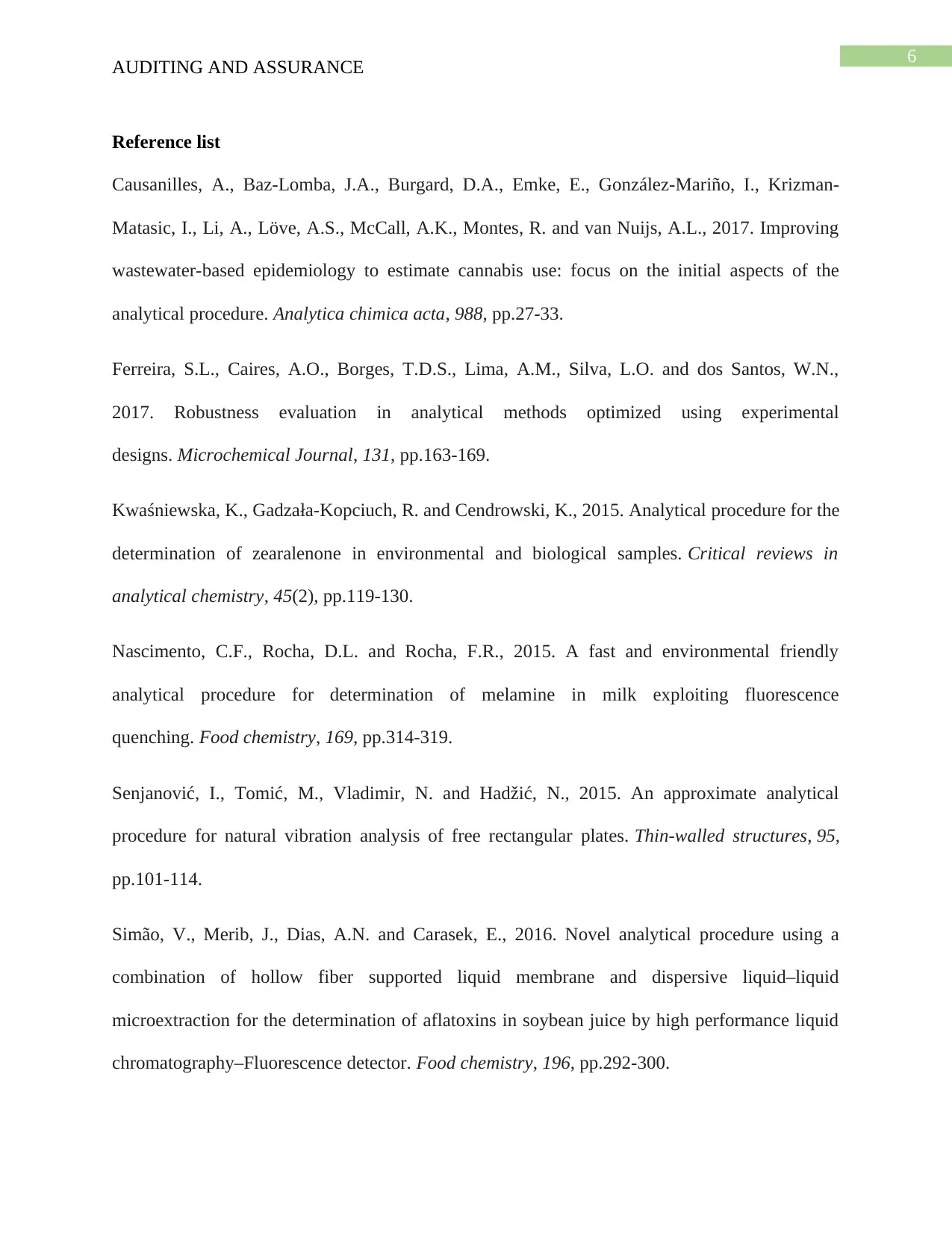
6
AUDITING AND ASSURANCE
Reference list
Causanilles, A., Baz-Lomba, J.A., Burgard, D.A., Emke, E., González-Mariño, I., Krizman-
Matasic, I., Li, A., Löve, A.S., McCall, A.K., Montes, R. and van Nuijs, A.L., 2017. Improving
wastewater-based epidemiology to estimate cannabis use: focus on the initial aspects of the
analytical procedure. Analytica chimica acta, 988, pp.27-33.
Ferreira, S.L., Caires, A.O., Borges, T.D.S., Lima, A.M., Silva, L.O. and dos Santos, W.N.,
2017. Robustness evaluation in analytical methods optimized using experimental
designs. Microchemical Journal, 131, pp.163-169.
Kwaśniewska, K., Gadzała-Kopciuch, R. and Cendrowski, K., 2015. Analytical procedure for the
determination of zearalenone in environmental and biological samples. Critical reviews in
analytical chemistry, 45(2), pp.119-130.
Nascimento, C.F., Rocha, D.L. and Rocha, F.R., 2015. A fast and environmental friendly
analytical procedure for determination of melamine in milk exploiting fluorescence
quenching. Food chemistry, 169, pp.314-319.
Senjanović, I., Tomić, M., Vladimir, N. and Hadžić, N., 2015. An approximate analytical
procedure for natural vibration analysis of free rectangular plates. Thin-walled structures, 95,
pp.101-114.
Simão, V., Merib, J., Dias, A.N. and Carasek, E., 2016. Novel analytical procedure using a
combination of hollow fiber supported liquid membrane and dispersive liquid–liquid
microextraction for the determination of aflatoxins in soybean juice by high performance liquid
chromatography–Fluorescence detector. Food chemistry, 196, pp.292-300.
AUDITING AND ASSURANCE
Reference list
Causanilles, A., Baz-Lomba, J.A., Burgard, D.A., Emke, E., González-Mariño, I., Krizman-
Matasic, I., Li, A., Löve, A.S., McCall, A.K., Montes, R. and van Nuijs, A.L., 2017. Improving
wastewater-based epidemiology to estimate cannabis use: focus on the initial aspects of the
analytical procedure. Analytica chimica acta, 988, pp.27-33.
Ferreira, S.L., Caires, A.O., Borges, T.D.S., Lima, A.M., Silva, L.O. and dos Santos, W.N.,
2017. Robustness evaluation in analytical methods optimized using experimental
designs. Microchemical Journal, 131, pp.163-169.
Kwaśniewska, K., Gadzała-Kopciuch, R. and Cendrowski, K., 2015. Analytical procedure for the
determination of zearalenone in environmental and biological samples. Critical reviews in
analytical chemistry, 45(2), pp.119-130.
Nascimento, C.F., Rocha, D.L. and Rocha, F.R., 2015. A fast and environmental friendly
analytical procedure for determination of melamine in milk exploiting fluorescence
quenching. Food chemistry, 169, pp.314-319.
Senjanović, I., Tomić, M., Vladimir, N. and Hadžić, N., 2015. An approximate analytical
procedure for natural vibration analysis of free rectangular plates. Thin-walled structures, 95,
pp.101-114.
Simão, V., Merib, J., Dias, A.N. and Carasek, E., 2016. Novel analytical procedure using a
combination of hollow fiber supported liquid membrane and dispersive liquid–liquid
microextraction for the determination of aflatoxins in soybean juice by high performance liquid
chromatography–Fluorescence detector. Food chemistry, 196, pp.292-300.
Paraphrase This Document
Need a fresh take? Get an instant paraphrase of this document with our AI Paraphraser

7
AUDITING AND ASSURANCE
Vaclavikova, M., Dzuman, Z., Lacina, O., Fenclova, M., Veprikova, Z., Zachariasova, M. and
Hajslova, J., 2015. Monitoring survey of patulin in a variety of fruit-based products using a
sensitive UHPLC–MS/MS analytical procedure. Food control, 47, pp.577-584.
Van Wychen, S. and Laurens, L.M., 2016. Determination of total carbohydrates in algal
biomass: laboratory analytical procedure (LAP) (No. NREL/TP-5100-60957). National
Renewable Energy Lab.(NREL), Golden, CO (United States).
AUDITING AND ASSURANCE
Vaclavikova, M., Dzuman, Z., Lacina, O., Fenclova, M., Veprikova, Z., Zachariasova, M. and
Hajslova, J., 2015. Monitoring survey of patulin in a variety of fruit-based products using a
sensitive UHPLC–MS/MS analytical procedure. Food control, 47, pp.577-584.
Van Wychen, S. and Laurens, L.M., 2016. Determination of total carbohydrates in algal
biomass: laboratory analytical procedure (LAP) (No. NREL/TP-5100-60957). National
Renewable Energy Lab.(NREL), Golden, CO (United States).
1 out of 8
Related Documents
Your All-in-One AI-Powered Toolkit for Academic Success.
+13062052269
info@desklib.com
Available 24*7 on WhatsApp / Email
![[object Object]](/_next/static/media/star-bottom.7253800d.svg)
Unlock your academic potential
Copyright © 2020–2025 A2Z Services. All Rights Reserved. Developed and managed by ZUCOL.





